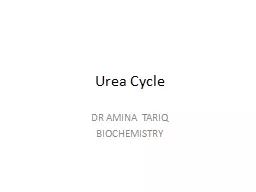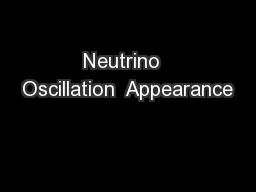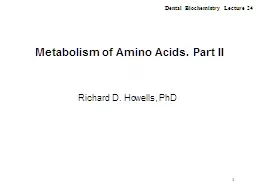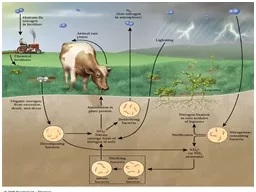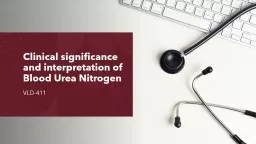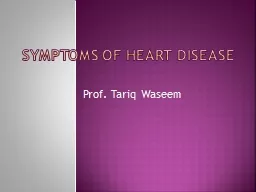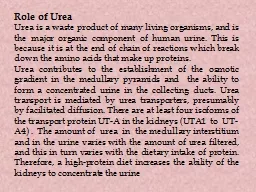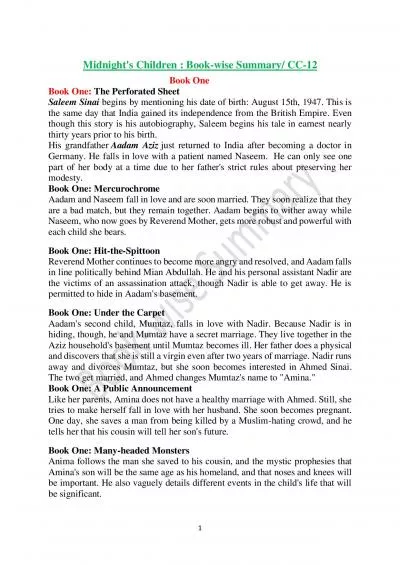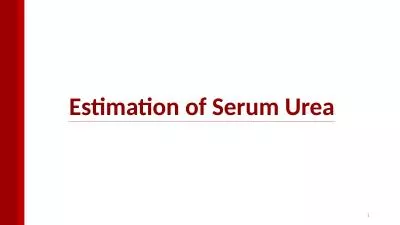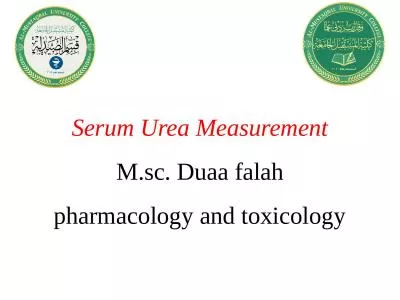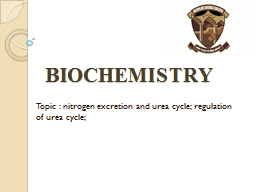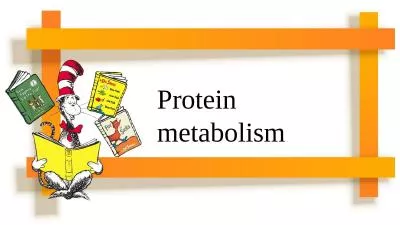PPT-Urea Cycle DR AMINA TARIQ
Author : tatiana-dople | Published Date : 2019-06-20
BIOCHEMISTRY Urea is the major disposal form of amino groups derived from amino acids and accounts for about 90 of the nitrogencontaining components of urine One
Presentation Embed Code
Download Presentation
Download Presentation The PPT/PDF document "Urea Cycle DR AMINA TARIQ" is the property of its rightful owner. Permission is granted to download and print the materials on this website for personal, non-commercial use only, and to display it on your personal computer provided you do not modify the materials and that you retain all copyright notices contained in the materials. By downloading content from our website, you accept the terms of this agreement.
Urea Cycle DR AMINA TARIQ: Transcript
BIOCHEMISTRY Urea is the major disposal form of amino groups derived from amino acids and accounts for about 90 of the nitrogencontaining components of urine One nitrogen of the urea molecule is supplied by free NH. BIOCHEMISTRY. Basic Characteristics Of Cell Signaling . Cell must respond appropriately to external stimuli to survive.. Cells respond to stimuli via cell signaling. Each cell is programmed to respond to specific combinations of extracellular signal molecules. . with. OPERA . Amina ZGHICHE . Oscillation Project with Emulsion . tRacking. Apparatus . Neutrino : a SM particle as any other. It fits in the SM picture. arXiv:hep-ex. /0509008. Phys.Rept. .427:257-454,2006. building blocks for protein synthesis. precursors of nucleotides and heme. source of energy. neurotransmitters. precursors of neurotransmitters and hormones. Outline of amino acid degradation. The liver is the major site of degradation for most amino acids, but muscle and kidney dominate the degradation of specific ones. Richard D. Howells, PhD. Dental Biochemistry Lecture 24. 2. Learning Objectives. To describe the urea cycle and its fundamental role in the excretion of nitrogen.. To . distinguish between . glucogenic. Approximately 75% are reutilized.. The excess nitrogen forms urea.. Proteins represent 10-15 % of total energy supply.. Digestion and Absorption of Proteins.. The . α. -amino group of many amino acids is transferred to . VLD-411. Urea or Blood Urea Nitrogen. Urea is the major excretory product of protein metabolism. formed in the liver from amino groups (−NH2) and free ammonia generated during protein catabolism. Enzymatically catalyzed process is termed the urea cycle. Introduction. The . Nitrogens. . compound present in highest concentration in the blood is urea.. Urea is the major excretory product of protein metabolism. It is formed in the liver from amino groups (-NH2) . Walking . Man. . By . Jonathan . Barofsky. . . Leopoldstrasse. Munich Germany. Prof. Tariq Waseem. Case 1. A 55 yrs old university professor has noticed chest tightness and heaviness while walking a distance of 300 meters from car parking to his department. The feeling is relieved if he stops midway for a while and does not occur at all when he walks in company of his colleagues or students. He felt similar chest congestion going uphill in Murree during last summer vacations. A friend suggested a pill to be kept in mouth while walking and he felt relieved.. .. Urea contributes to the establishment of the osmotic gradient in the . medullary. pyramids and the ability to form a concentrated urine in the collecting ducts. Urea transport is mediated by urea transporters, presumably by facilitated diffusion. There are at least four . 1 : Book - wise Summary / CC - 12 Book One Book One: The Perforated Sheet Saleem Sinai begins by mentioning his date of birth: August 15th, 1947. This is the same day that India gained its independen 1. -Urea: . Urea is the highest . non-protein nitrogen . compound in the blood.. Urea is the major . excretory product of protein metabolism. .. It is formed by . urea cycle in the liver . from . free ammonia . . Duaa. . falah. pharmacology and toxicology. Urea. Urea is the highest non-protein nitrogen compound in the blood. . Urea . is the major excretory product of protein metabolism.. . It . is formed in the liver from free ammonia generated during protein catabolism. . excretion and urea cycle; regulation of urea cycle;. Nitrogen excretion:. Nitrogen excretion means elimination of nitrogen containing compounds from an organism.. Urine is the main rout for such excretion, also take place through feces.. . INTRODUCTION. PROTEIN TURNOVER. AMMINO ACID POOL. METABOLISM OF AMMONIA . UTILIZATION OF AMMONIA . TRANSPORT OF AMMONIA. UREA CYCLE . REGULATION OF UREA CYCLE.. Introduction. – . protein metabolism Denotes the various biochemical Processes Responsible for the Synthesis of protein and amino acids the breakdown of proteins by catabolism..
Download Document
Here is the link to download the presentation.
"Urea Cycle DR AMINA TARIQ"The content belongs to its owner. You may download and print it for personal use, without modification, and keep all copyright notices. By downloading, you agree to these terms.
Related Documents

